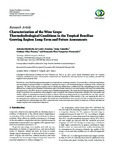Por favor, use este identificador para citar o enlazar este ítem:
http://www.alice.cnptia.embrapa.br/alice/handle/doc/991131Registro completo de metadatos
| Campo DC | Valor | Lengua/Idioma |
|---|---|---|
| dc.contributor.author | TEIXEIRA, A. H. de C. | pt_BR |
| dc.contributor.author | TONIETTO, J. | pt_BR |
| dc.contributor.author | PEREIRA, G. E. | pt_BR |
| dc.contributor.author | HERNANDEZ, F. B. T. | pt_BR |
| dc.date.accessioned | 2017-04-26T23:48:47Z | - |
| dc.date.available | 2017-04-26T23:48:47Z | - |
| dc.date.created | 2014-07-22 | pt_BR |
| dc.date.issued | 2014 | pt_BR |
| dc.identifier.citation | ISRN Agronomy, v. 2014, p. 1-14, 2014. | pt_BR |
| dc.identifier.uri | http://www.alice.cnptia.embrapa.br/alice/handle/doc/991131 | pt_BR |
| dc.description | Over the last years, Brazil has appeared among the newtropicalwine producing countries.Thejoined effect of rising air temperature and decreasing precipitation makes it important to quantify the trend of the thermohydrological conditions of the commercial vineyards. The aims of the current research were to classify and delimit these conditions for the winemaking processes under different time scenarios in the BrazilianNortheastern region. Bioclimatic indicatorswere used togetherwith long-termweather ata and projections of the IPCC emission scenarios under simulated pruning dates. The results showed that decreasing of precipitation should be good for wine production when irrigation water is available, but rising air temperature will affect the wine quality and stability mainly for pruning done from November to March. The best pruning periods are around May for any time scenario considered. In general, more care should be taken for pruning happening in other periods of the year, regarding the effect of increasing thermal conditions on wine quality.The classification and delimitation done, joined with other ecological characteristics, are important for a rational planning of the commercial wine production expansion, mainly in situations of climate and land use changes together with rising water competition in the Brazilian Northeast region. | pt_BR |
| dc.language.iso | eng | eng |
| dc.rights | openAccess | eng |
| dc.subject | Uva de vinho | pt_BR |
| dc.subject | Bioclimatic indicators | pt_BR |
| dc.title | Characterization of the Wine Grape Thermohydrological Conditions in the Tropical Brazilian Growing Region: Long-Term and Future Assessments. | pt_BR |
| dc.type | Artigo de periódico | pt_BR |
| dc.date.updated | 2017-04-26T23:48:47Z | pt_BR |
| dc.subject.thesagro | Ar | pt_BR |
| dc.subject.thesagro | Bioclimatologia | pt_BR |
| dc.subject.thesagro | Condicao ambiental | pt_BR |
| dc.subject.thesagro | Poda | pt_BR |
| dc.subject.thesagro | Precipitacao pluvial | pt_BR |
| dc.subject.thesagro | Temperatura | pt_BR |
| dc.subject.thesagro | Vinho | pt_BR |
| dc.subject.thesagro | Viticultura | pt_BR |
| dc.subject.thesagro | Uva | pt_BR |
| dc.subject.thesagro | Vitis Vinifera | pt_BR |
| dc.subject.nalthesaurus | Air temperature | pt_BR |
| dc.subject.nalthesaurus | Atmospheric precipitation | pt_BR |
| dc.subject.nalthesaurus | Viticulture | pt_BR |
| riaa.ainfo.id | 991131 | pt_BR |
| riaa.ainfo.lastupdate | 2017-04-26 | pt_BR |
| dc.identifier.doi | 10.1155/2014/727123 | pt_BR |
| dc.contributor.institution | ANTONIO HERIBERTO DE C TEIXEIRA, CNPM; JORGE TONIETTO, CNPUV; GIULIANO ELIAS PEREIRA, CNPUV / CPATSA; FERNANDO BRAZ TANGERINO HERNANDEZ, USP. | pt_BR |
| Aparece en las colecciones: | Artigo em periódico indexado (CPATSA)  | |
Ficheros en este ítem:
| Fichero | Descripción | Tamaño | Formato | |
|---|---|---|---|---|
| Giuliano2014.pdf | 5,8 MB | Adobe PDF |  Visualizar/Abrir |









